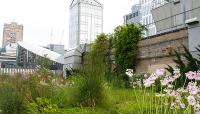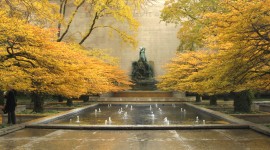Completed in 2001, this green roof tops the Classical Revival building that has served as the Chicago City Hall since it was completed in 1911. The building, which occupies an entire city block just south of the Chicago River, is an eleven-story rectangular structure with an open courtyard in its center. The green roof covers the western half of the building, some 20,300 square feet of its overall 38,800 square-foot surface. After a heat wave killed several Chicago residents in 1995, Mayor Richard M. Daley and the City’s Department of Environment promoted the highly visible demonstration project.
Designed by Conservation Design Forum and Atelier Dreiseitl, the green roof comprises more than 20,000 plants arranged within several rectangular blocks. The blocks are planted according to bloom cycles such that, as the seasons progress, over 150 species of prairie and woodland plants evolve in radial bands of color, form, and texture. Native grasses, herbaceous plants, flowering shrubs, and two trees (a prairie crabapple and a cockspur hawthorn) provide forage for wild pollinators, as well as honeybee colonies maintained on the roof. The undulating surface—comprising layers of insulation and lightweight soils at varying depths—provides temperature control and moisture absorption. The planted side of the roof registers seven degrees cooler than the unplanted side, and captures some 75% of rainwater (stored in a cistern in the penthouse below). A year after it was installed, the project received a Merit Award in Design from the American Society of Landscape Architects.

















